|
1.
CENTRAL AND WEST AFRICA
Downturn in major markets of concern
As the year comes to a close the timber industries in the
region face a challenging landscape with notable
developments in various markets. For China, the
Philippines and Middle East countries producers describe
the prospects as disastrous as these key markets are
showing a significant demand downturn with purchases
limited to only particular species and specific sizes
negotiated contract by contract.
Heavy rain taking a toll on production
In the region heavy rain has taken a toll on production
especially in Central African countries but hopes are
rising for better conditions as the dry season should arrive
in Cameroon and North Congo by mid to end December.
In Gabon producers say they have experienced a
disappointing two months with demand for okoume being
very quiet and this has impacted peeler mills in special
economic zones.
The new government in Gabon is implementing significant
reforms in the Special Economic Zone of NKOK to
address issues such as irregular social security payments,
low salaries and concerns on overtime. The military
presence at NKOK has contributed to an improvement in
labour discipline say producers.
Over the past month there were no changes or additions to
government regulations. The private sector hopes the issue
of so called ‘mission fees’ will be examined as part of the
new Minister’s review of the sector workforce structure
and operations, The outcome of this review is expected to
be made available by the end of December or early
January 2024. The industry is bracing for potential
surprises, suspecting irregularities and discrepancies
within the system may be exposed.
President meets Gabon forestry sector stakeholders
The Gabon Review has reported on a meeting of
stakeholders in the forestry sector with the President of the
Transitional government, Brice Clotaire Oligui Nguema.
It is reported that the meeting provided an opportunity for
the President to learn of the constraints and opportunities
faced by the forestry sector and envisage an attractive and
better regulated business climate and environment for
busineses. It was reported that excluding hydrocarbons,
the forestry sector contributes around 60% of GDP and
supports an estimated 20,000 direct and 14,000 indirect
jobs.
According to a Presidential Communication reported in
the domestic media 3.4 million cubic metres of wood are
processed in Gabon each year and the Communication
recognised that the sector is experiencing weakness in
internal and international markets and many challenges in
production such as rising fuel costs, problems with VAT
reimbursement and challenging infrastructure, especially
concerning road and rail transport.
The President and the Forestry Minister committed to a
revitalisation of the forestry sector and indicated that all
ministries which deal with the forestry and infrastructure
sectors must pool their efforts and work together to
address the constraints facing the private sector. The
Minister is reported as saying “the observation is that
forestry operators are having difficulty adopting industrial
approaches that guarantee dynamic and sustainable
exploitation of the resource hence the need for the
Gabonese authorities to support companies to improve
their competitiveness”.
See:
https://www.gabonreview.com/gabon-le-secteur-foret-bois-au-revelateur-doligui-nguema/
Cameroon update
Even at this early date there is considerable speculation in
Cameroon on the 2025 presidential elections and how a
change may impact the forestry sector. Producers in
Cameroon face many challenges especially the heavy
persistent rains which have led to a significant slowdown
in harvesting activities.
The overall situation remains unchanged from the last
report with approximately 30% of operators and mills
being affected by adverse weather. However, there is
optimism that the rains will subside as the dry season is
expected to begin at the end of December and will likely
last for 5-6 months.
Road conditions for transporting timber from forests to
mills and log depots have not improved since the last
report. Rail operations remain stable ensuring the
continued transportation of wood products. Container
availability in Cameroon is reported to be adequate with
no reports of disruptions in stuffing operations. Douala
and Kribi ports said to be operating normally. Reports
suggest log stocks in Kribi remain low.
The domestic media in Cameroon continue to focus on
political news with no significant updates on trade,
manufacturing or the economy.
 
EUTR expert group briefed on Gabon
The ATIBT published two articles in September and
October on Gabon's timber imports and the EUTR the first
following a meeting of the European Commission, the
other following exchanges between the ATIBT and the
Commission's Directorate-General for the Environment.
As a follow-up the ATIBT was invited to present Gabon's
situation at a meeting of the EUTR expert group in late
November.
See:
https://www.atibt.org/en/news/13421/gabon-the-latest-news-in-the-timber-sector
Through the eyes of industry
The latest GTI report lists the challenges identified by the private
sector in the Republic of Congo and Gabon.
See:
https://www.itto-ggsc.org/static/upload/file/20231215/1702603888131489.pdf
2.
GHANA
Tertiary wood product exports decline in three
consecutive quarters
Data on the country’s quarterly wood product exports
published by the Timber Industry Development Division
(TIDD) showed that export volumes of tertiary wood
product (TWP) comprising dowels and mouldings
declined in the first three quarters of 2023 while export
volumes of primary and secondary product exhibited
mixed trends.
Kiln dry sawnwood, plywood, sliced and rotary veneers,
briquettes, kiln dry boules maded up the bulk of the
country’s wood product exports and generated the highest
volumes in each of the three quarters of 2023. The
volumes recorded for first quarter, second quarter and
third quarter were 66,972cu.m, 72,106cu.m and
21,695cu.m.

Primary Products, mainly billets and teak logs, also
recorded moderate export volume increases i.e. from
6,817cu.m in the first quarter to 7,247cu.m in the second
quarter.
However, export volumes in the third quarter spiked to
45,133cu.m. due to new directives from the Grading and
Inspection Department of the TIDD on data capture in
which air-dried products were recorded as primary
products and kiln-dried products as secondary products.
Following the new directive air dry sawnwood accounted
for over 90% of total primary products exported in the
third quarter with four other products accounting for only
8%, shown below;
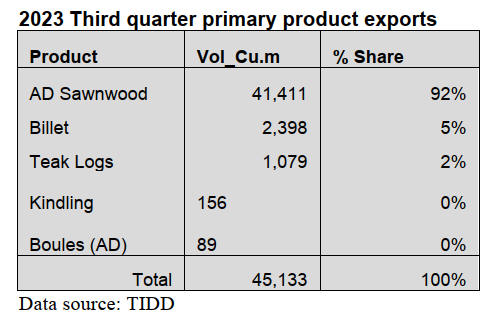
Tertiary wood products (mouldings and dowels)
contributed Eur1.58million from a volume of 1,957cu.m to
total wood products exports in the third quarter of 2023.
The figures represent decreases of 16% and 25% in value
and volume respectively compared to the contribution of
Eur1.87million and 2,600cu.m in the third quarter of 2022.
Ghana signs Emission Reduction Agreement at
COP 28
The Forestry Commission, under the auspices of the
Ministry of Lands and Natural Resources, has signed an
Emission Reductions Payment Agreement (ERPA) with
Emergent Forest Finance Accelerator Incorporated
(Emergent), a US-based non-profit organisation that serves
as the convener and coordinator of the Lowering
Emissions by Accelerating Forest Finance (LEAF)
Coalition.
Through the Agreement Ghana will receive up to Fifty
Million US Dollars (US$50 million) for emission
reductions of up to five million tonnes of carbon dioxide
equivalent at a unit price of ten Dollars (US$10.00) per
tonne of carbon dioxide equivalent.
The Agreement was signed on the sidelines of the twenty-
eighth session of the Conference of Parties (COP28) of the
United Nations Framework Convention on Climate
Change (UNFCCC). This made Ghana the first country in
the world, to sign an ERPA under the LEAF Coalition for
the supply of high-integrity jurisdictional REDD+
emission reductions and removals credit.
According to Abu Jinapor, Sector Minister in the Ministry
of Lands and Natural Resources (MLNR) the new
agreement complements other interventions by
government to address climate change such as the flagship
Green Ghana Project, the Ghana Forest Plantation Strategy
and the Ghana REDD+ Strategy.
See:
https://fcghana.org/ghana-signs-us50m-emission-reduction-payment-agreement-under-leaf-coalition/
Forest industries pool resources to optimise
operations
Some private business associations operating under the
Forest Industries Association of Ghana (FIAG) have
formed a united front to address common challenges while
pursuing a sustainable operational model.
According to Richard Nsenkyire, President of the
Association, the priority areas include “ensuring
sustainability by promoting adoption of circular and green
economic principles in their business practices.” He cited
examples where some processing companies are retooling
to be able to use more of their residues while others are
supplying their residues to other companies for further
processing”.
Mr. Nsenkyire indicated the goal of FIAG was to enhance
corporate performance, have a common voice on concerns
and forge a strong entity to continue contributing to the
socio-economic development of Ghana’s forest processing
sector.
FIAG is an umbrella body of players in the timber and
wood related business in the country from 10 timber trade
associations which collectively employ over 300,000 in
the areas of plantation development, logging, milling,
manufacturing, haulage and equipment services, sales and
marketing.
See:
https://www.myjoyonline.com/forest-industries-in-ghana-build-synergies-for-green-sustainable-future/
US$200 million for tree crop diversification
Parliament has approved a US$200 million loan agreement
with the World Bank for the financing the Ghana Tree
Crop Diversification Project (GTCDP) whicjh expected to
boost production and add value to six strategic tree crops.
The Chairman of the Finance Committee, Kwaku
Kwarteng, said the GTCDP would help improve the
economic, climate and social resilience in the productivity
and value addition of the strategic tree crops. He
mentioned cocoa, cashew, shea, mango, coconut, rubber
and oil palm; would be grown in 11 selected districts
across five regions being Western North, Eastern,
Savannah, Bono and Bono East regions.
See:
https://www.graphic.com.gh/news/general-news/ghana-news-parliament-approves-3-loan-agreements.html
Farmers call for reforms in off-reserve timber
resources
Cocoa farmers in the North Western Region of the country
have called on government and industry stakeholders to
initiate steps to amend the Concession Act 1962 (Act 124)
to ensure farmers earn reasonable benefits from the
commercialisation of off-reserve timber resources.
Farmers complain the existing tree tenure and benefit
sharing arrangements for off-reserve timber resources
under Act 124 is unfavourable to farmers.
Tropenbos Ghana a non-governmental organisation has,
on behalf of the farmers, called on the Forestry
Commission of Ghana to take steps to revisit the
Concession Act 1962 (Act 124) which gives the state full
authourity over all naturally occurring trees to the
disadvantage of farmers havmg commercial timber trees
on their land.
According to the Project Manager of Tropenbos Ghana,
Boakye Twumasi Ankra, the Act took away tree
ownership rights from farmers which discourages them
managing these trees as a resource.
See:
https://gna.org.gh/2023/12/cocoa-farmers-in-western-north-call-for-reforms-in-off-reserve-timber-resources/
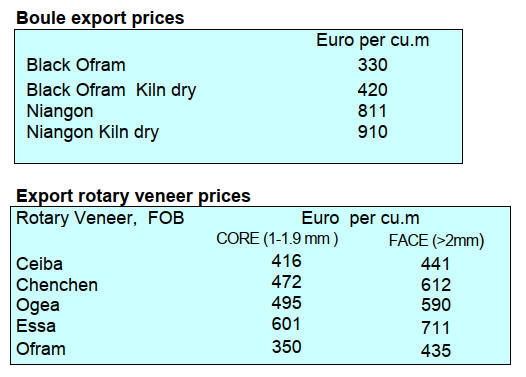 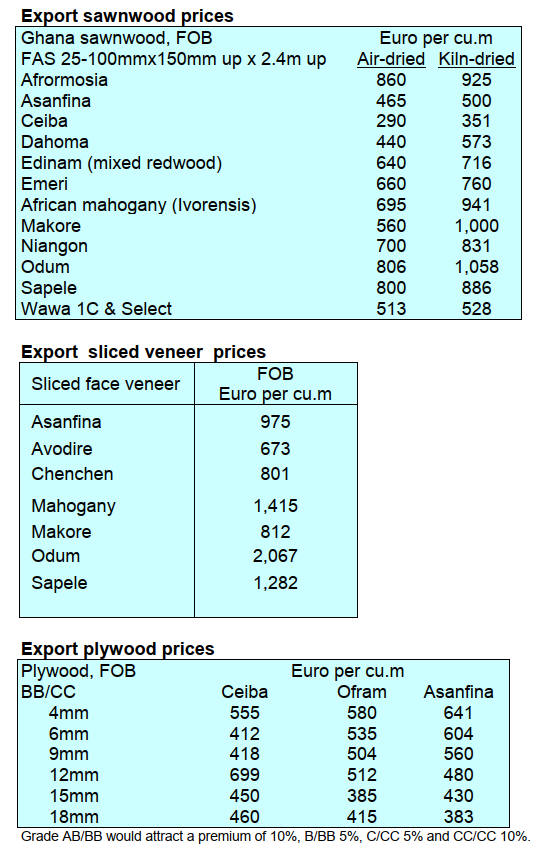
3. MALAYSIA
Drivers of GDP growth in 2024
Malaysia’s GDP growth is expected to improve to 4.7% in
2024 supported by a recovery in external trade and
sustained growth in domestic demand. Positive job market
conditions, income growth and continued recovery in the
tourism sector would also support the economy. Inflation
is forecast to be above 3% next year being moderated by
fuel subsidies.
A recovery in China and supportive global commodity
prices are expected to boost Malaysia’s export earnings in
2024. The domestic economy is expected to be anchored
by continuous steady consumer spending, busier tourism-
related activities and investment in infrastructure.
See:
https://www.thestar.com.my/business/business-news/2023/12/07/midf-research-expects-malaysia039s-gdp-growth-to-improve-to-47-in-2024
Support for more investment in biomass sector
The Plantation and Commodities Minister, Fadillah Yusof,
recently launched the National Biomass Action Plan 2023-
2030 (NBAP2030) to support increased investments in the
biomass industry aimed at creating around 3,000 jobs. The
Action Plan was developed based on the National Agro-
commodity Policy (NAP) 2021-2030 and is aimed at
boosting the biomass sector.
The Action Plan also calls for establishing biomass hubs to
carry out centralised and systematic collection of biomass
raw materials to drive the national biomass supply chain
systematically and efficiently.
See:
https://www.thestar.com.my/news/nation/2023/12/07/malaysia-can-save-rm7bil-by-using-biomass-pellets-as-energy-source-says-dpm-fadillah
New scheme to raise wages
The government is introducing a programme to raise
wages for more than 1 million low-income workers as the
country grapples with rising living costs and growing
inequality.
The scheme, which targets the small and midsize
businesses that account for the vast majority of Malaysia's
workforce, will be implemented in stages and is meant to
complement the existing minimum wage policy.
See:
https://asia.nikkei.com/Economy/Malaysia-plans-new-wage-scheme-for-low-income-workers?utm_campaign=IC_asia_daily_free&utm_medium=email&utm_source=NA_newsletter&utm_content=article_link
Chairman of STA speaks on challenges in timber
supply chains
In the recent Global Legal & Sustainability Timber Forum
2023 held in Macau a presentation was made by Henry
Lau, Chairman of the Sarawak Timber Association (STA)
addressing ‘Challenges and difficulties on international
cooperation in timber supply chains’. He listed the
following concerns:
a) Timber players labelled as culprits. “Timber industry
players are frequently labelled, described and perceived as
culprits solely driven by economic gain and often
neglecting broader concerns. In reality, when illegal
activities take place there is a tendency to assume that
operators from timber industry are involved prioritising
economic gain over the well being of forests and the
environment”.
b) Where can responsible timber players find help? “For
those who are committed to carrying out their timber
activities with an emphasis on delivering economic values
while equally maintaining social and environmental well-
being and good governance where can they find help and
assistance? In fact, many view the cessation of forest
harvesting for economic gain as absurd saying failing to
realise that if the forests have no economic value they are
vulnerable to conversion for other uses”.
c) Uncertainties in tenure security. “Apart from being
consistently placed in the front line by almost everyone
else timber players are also facing uncertainties in tenure
security. Timber players require long and secure tenure to
implement sustainable forest management in line with the
17 Sustainable Development Goals (SDG) of the United
Nations.
However, Lau asserted that most of the timber players
throughout Malaysia and Sarawak in particular, are facing
insecurity of tenure. What is the effect of these
uncertainties? It was proposed that all stakeholders should
incorporate this issue and remove this constraint to
achieve economic, social and environmental goals”.
d) Complexities and disparities in consumer country
legislation. “Another challenge faced is that of ensuring
compliance with various timber legislation enforced by
consumer countries as well as gaining market recognition
for the efforts undertaken by producing countries. The
timber legislation can be highly complex and differs
significantly from one country to another. Inconsistent
definitions, regulations and requirements can create trade
barriers and confusion in international cooperation
efforts”.
e) EUDR. “This regulation poses a significant challenge
for tropical timber-producing countries because they still
need to develop their economies. This situation could lead
to a vicious cycle where market share is lost, producers
experience reduced incomes potentially increasing poverty
which in turn may contribute to an increase in
deforestation through forest clearing as a means of
survival”.
f) Timber products a more sustainable material. “The rise
of alternative materials like plastics, steel, aluminium,
composites and engineered wood products has made them
an increasingly popular choice for consumers. This poses a
threat to the timber industry as it could reduce the demand
for wood products. More efforts are required to promote
the utilisation of wood as a sustainable materials in
alignment with the concept of a circular bio-economy”.
See:
https://sta.org.my/images/Forumpaper21112023FINAL.pdf
Undersanding forest ecosystem functions to promote
SFM
The Sarawak Forest Department and the National Institute
for Environmental Studies (NIES) in Japan have signed a
memorandum of understanding on collaboration in
research activities for sustainable forest management. The
focus will be on developing an effective methodology for
the evaluation and implementation of essential forest
ecosystem functions and services to promote SFM and
conservation as outlined in the global biodiversity
frameworks under United Nations.
Other areas of cooperation covered under the MoU include
collaboration in forest ecosystem and biodiversity
conservation, establishing a standard research
methodology for Permanent Sample Plot networks and
joint publication of findings together with workshops,
conferences and training.
See:
https://theborneopost.pressreader.com/article/281904482942186
Through the eyes of industry
The latest GTI report lists the challenges identified by the private
sector in Malaysia
See:
https://www.itto-ggsc.org/static/upload/file/20231215/1702603888131489.pdf
4.
INDONESIA
Export Benchmark Prices
December 2023
The following is a list of benchmark prices for December
2023.

Processed Wood
Processed wood products which are leveled on all four
sides so that the surface becomes even and smooth with
the provisions of a cross-sectional area of 1000 sq.mm to
4000sq. mm (ex 4407.11.00 to ex 4407.99.90)
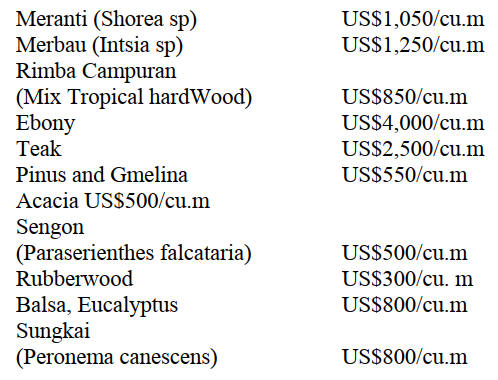
Processed wood products which are leveled on all
four
sides so that the surface becomes even and smooth with
the provisions of a cross-sectional area of 4000 sq.mm to
10000 sq.mm (ex 4407.11.00 to ex 4407.99.90)

See:
https://jdih.kemendag.go.id/pdf/Regulasi/2023/Kepmendag%20Nomor%201964%20Tahun%202023.pdf
Healthy domestic economy to spur greater plywood
consumption
The Indonesian Wood Panel Association (Apkindo)
believes that 2024 will see a favorable domestic market
situation that will further drive demand for plywood. This
message was from Bambang Soepijanto after being re-
elected as the General Chair of Apkindo for the 2023-2028
term at the 9th Apkindo National Conference.
In his message he highlighted the domestic market
opportunities saying the latest data shows that investment
in various sectors grew to IDR1,207 trillion which will
drive up domestic demand for plywood. In addition to
private investment the central and regional authorities will
invest in the development of the Indonesian Capital City
(IKN) and this is expected to boost demand for plywood.
Earlier, Bambang mentioned that the national plywood
industry has been impacted by significant challenges such
as the COVID-19 pandemic, a sharp rise in shipping costs,
the US-China trade dispute, and the Russia-Ukraine war
which triggered a global economic downturn. However,
despite headwinds, the plywood industry has survived in
the face of the downturn in exports which was first
observed from the second half of 2022.
See:
https://agroindonesia.co.id/apkindo-industri-kehutanan-masih-bisa-diandalkan/
In related news, at opening of the 9th National Conference
of the Indonesian Wood Panel Association the Minister of
Environment and Forestry, Siti Nurbaya, conveyed a
message that the wood panel industry should not be overly
concerned on the EUDR as the regulation acknowledges
the Indonesian SVLK for wood products as indicated in
paragraph 81 of the EUDR where wood products are
required to meet 8 criteria. However, it will be necessary
to provide geo-location coordinates.
See:
https://agroindonesia.co.id/eudr-akui-keberadaan-svlk/
COP28 commitment to achieving NZE target sooner
than 2060
President Joko Widodo reiterated Indonesia's firm
commitment to achieve the net-zero emissions (NZE)
target sooner than 2060 for the sake of realising an
inclusive economy and emerging as a prosperous and
sustainable country.
According to a press statement the president made this
statement in his speech at the Conference of the Parties 28
(COP28) in Dubai.
He noted that Indonesia has been consistent in reducing
carbon emissions by improving the management of the
land and forests and expediting the clean energy transition.
The President emphasised that Indonesia is successfully
reducing the rate of deforestation.
See:https://en.antaranews.com/news/300021/cop28-indonesia-committed-to-achieving-nze-target-sooner-than-2060
During the negotiations at COP28 Indonesia reaffirmed its
efforts to cooperate with Brazil and the Democratic
Republic of Congo through trilateral understanding
reached during the COP26. The cooperation aims to
strengthen the influence of the world's three largest
tropical forest owners in climate negotiations, including
promoting results-based funding for emissions reduction
from deforestation and forest degradation plus (REDD+).
See:https://www.kompas.id/baca/english/2023/12/02/en-bersama-brasil-dan-kongo-indonesia-tegaskan-lagi-penurunan-emisi-di-sektor-kehutanan
and
https://www.msn.com/id-id/ekonomi/ekonomi/indonesia-brasil-dan-kongo-perkuat-pengelolaan-hutan-tropis/ar-AA1kRW5R
Indonesia, a role model for community-based
climate
resilience
At the 10th Facilitative Working Group - Local
Communities and Indigenous People Platform Road,
Pirawan Wongnithisathaporn, from the Asia Indigenous
Peoples Pact Foundation in Thailand said Indonesia’s
efforts on community-based climate resilience is a world
role model especially for indigenous communities.
Indonesia was represented by Bambang Supriyanto,
Director General of Social Forestry and Environmental
Partnerships who spoke on the development and
recognition of indigenous peoples under the Social
Forestry programme as well as through multi-party
collaboration in empowerment efforts based on local
wisdom for forest sustainability and alternative
livelihoods.
In addition, Bambang reported that the Indonesian
government also collaborates with international
institutions through the Forest Programme project in
Sanggau, West Kalimantan and the Social Forestry
Strengthening Project in four provinces in order to
increase multi-stakeholder assistance activities such as:
increasing and strengthening of livelihoods as well as
improving sustainable forest management.
See:
https://www.menlhk.go.id/news/indonesia-menjadi-role-model-ketahanan-iklim-berbasis-masyarakat/
Opportunities in production of wood pellets for
renewable energy
Several companies are considering the commercial
potential in the wood pellet industry. This sector is
expected to grow due to the global movement toward
renewable energy sources and in Indonesia several
companies are investing in wood pellet factories. For
example PT Indika Energy Tbk (INDY) is allocating
US$21 million for its factory project this year.
The factory is expected to be operational by year end with
a production capacity of 10 tonnes per hour. Also, PT
Maharaksa Biru Energi Tbk (OASA) is developing
renewable energy projects by constructing biomass-based
factories in Bangka, Blora, and Banten.
Another company, PT Sumber Global Energy Tbk
(SGER) has diversified its business by selling processed
wood pellets to the energy industry. In other news, PT
Mitra Biomass International, a joint venture company
between PT Mitra Investindo Tbk, PT Pima Aset Lestari
and Interra Resorts Limited are also in the wood pellet
business.
See:
https://industri.kontan.co.id/news/menilik-potensi-cuan-bisnis-wood-pellet-untuk-energi-terbarukan
Ministry aims to achieve 8 million hectares of social
forestry by 2024
The Ministry of Environment and Forestry (KLHK) is
optimistic that it can realise 8 million hectares of social
forestry approvals by 2024. Bambang Supriyanto, the
Director General of Social Forestry and Environmental
Partnerships at the Ministry of Environment and Forestry,
stated that as of September 2023, social forestry approvals
have been granted for 6.3 million hectares, approximately
half of the 12.7 million hectare target.
Bambang explained that social forestry, a national
strategic project, had been progressing slowly due to a
35% budget cut during the three-year COVID-19
pandemic.
See:
https://www.antaranews.com/berita/3835443/klhk-optimistis-selesaikan-8-juta-hektare-perhutanan-sosial-pada-2024
Rehabilitation of 600,000 hectares of mangrove forest
The Indonesian government has set a target to restore
600,000 hectares of mangrove forest by the end of 2024.
The Ministry of Environment and Forestry (KLHK) is
requesting support and involvement from organisations,
institutions, ministries and local communities to achieve
this goal. The Director of Inland Water and Mangrove
Rehabilitation at the Ministry of Environment and
Forestry, Inge Retnowati, said that this target is contained
in Presidential Regulation (Perpres) Number 120 of 2020
concerning the Peat and Mangrove Restoration Agency
(BRGM).
The Decree aims to accelerate implementation of
mangrove rehabilitation in North Sumatra, Riau, Riau
Islands, Bangka Belitung, West Kalimantan, East
Kalimantan, North Kalimantan, Papua and West Papua.
See:
https://lestari.kompas.com/read/2023/11/23/110000686/indonesia-targetkan-rehabilitasi-600.000-hektare-lahan-mangrove?page=1
Diversifying export markets
The government is encouraging companies to target new
markets such as India, ASEAN, Africa and Latin America
to boost export growth. Trade Minister, Zulkifli Hasan,
explained that a task force on this issue has been
established. Hasan explained that the task force is also
responsible for accelerating the completion of negotiations
on comprehensive economic partnership agreements,
especially the Indonesia-European Union Economic
Partnership.
See:
https://en.antaranews.com/news/299637/govt-encourages-exports-to-new-destinations-to-boost-export-growth
Through the eyes of industry
The latest GTI report lists the challenges identified by the private
sector in Indonesia
https://www.itto-ggsc.org/static/upload/file/20231121/1700552181514582.pdf
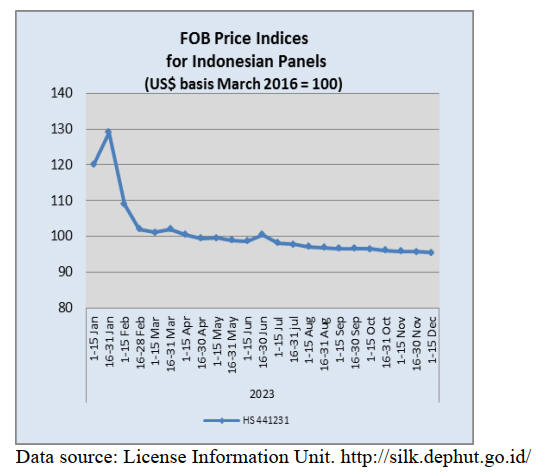
5.
MYANMAR
Certification body seeks assistance in accreditation
A recent post on the Myanmar Forest Certification
Committee (MFCC) website mentions cooperation
between MFCC and counterparts in Vietnam to address
issues of accreditation of the certification bodies who are
notified by MFCC.
The post mentions that “in a significant step towards
promoting sustainable forest practices and gaining
international recognition for national certification bodies,
MFCC joined a study tour to Vietnam with the Myanmar
Accreditation Body (MAB) and the Certification Bodies
(CB) notified by MFCC.
The post adds that the MFCC sought assistance from the
Vietnam Bureau of Accreditation (BoA) after the MFCC
had tried unsuccessfully to cooperate with SAC
(Singapore Accreditation Council ) for a Joint-Assessment
between Myanmar Accreditation Body and SAC for the
Accreditation to Myanmar certification bodies.
Since the Myanmar Accreditation Body is not a member
of any International Accreditation Forum, it alone cannot
accredit CBs in Myanmar. Against this background the
Myanmar Accreditation Body had to consider cooperating
with another National Accreditation Body for a joint-
assessment of the Myanmar’s CBs.
It is understood that in, the absence of international
accreditation, Myanmar CBs were not recognised in
international markets and the Myanmar conformity
assessment reports on the legality of Myanmar Forest
Products were viewed as unverifiable.
The cooperation with Vietnam was carried out under an
ITTO-MFCC Project and the joint-assessment process was
outlined between Myanmar and Vietnam which, it is
hoped, will lead to the international recognition of
Myanmar Certification Bodies.
See:
https://myanmarforestcertification.org/strengthening-sustainable-forest-management-a-collaboration-journey-of-mfcc-in-vietnam-together-with-myanmar-accreditation-bodymab-and-certification-bodies-cbs/
World Bank - 1% growth forecast
In a 12 December press release on the World Bank’s semi-
annual Myanmar Economic Monitor the Bank says little
economic growth is expected in Myanmar in the near
term, as rising conflict, trade and logistics disruptions,
kyat volatility and high inflation combine to negatively
impact businesses and households.
The release continues “Myanmar’s economy is projected
to grow by just 1% over the year to March 2024,
according to the report ‘Challenges amid conflict’ conflict
has escalated across much of Myanmar since October,
leading to the displacement of an estimated half a million
people, disrupting key overland trade routes and
increasing logistics costs.
Even if conflict does not escalate further, growth is
expected to remain subdued over the rest of 2024 and into
2025 given a broad-based slowdown across productive
sectors including agriculture, manufacturing, and trade.
The size of Myanmar’s economy remains around 10%
lower than it was in 2019, leaving it the only economy in
East Asia that has not returned to pre-pandemic levels of
economic activity.”
The press release adds,” indicators of business activity
have worsened since mid-2023. Firms reported operating
at just 56% of their capacity in September.”
See:
https://www.worldbank.org/en/news/press-release/2023/12/12/economic-recovery-falters-as-conflict-and-inflation-weigh#:~:text=Myanmar's%20economy%20is%20projected%20to,the%20report%2C%20Challenges%20amid%20conflict.
and
https://www.irrawaddy.com/business/economy/world-bank-myanmars-growth-to-fall-to-1-percent
Efforts to ease exchange controls to favor exporters
On 5 December the Central Bank of Myanmar (CBM)
announced that it will no longer determine the foreign
exchange rate on foreign currency transactions made
through authorised dealer banks via the foreign exchange
online trading system.
Consequently, sellers and buyers are now free to
determine the foreign exchange rate for their transactions
based on the market rate. At the same time, outbound
foreign currency remittances must still adhere to the
procedures issued by the Foreign Exchange Supervisory
Committee.
It appears that through these actions the CBM is aiming to
encourage and boost the country’s exports since exporters
stand to gain the most from these relaxations.
However, it is still mandatory for Myanmar exporters to
convert their foreign currency earnings at the reference
exchange rate of 2,100 kyats per dollar for 35% of export
earnings. After the announcement fuel prices has soared
about by 10%.
In related news, The Myanmar currency (Kyat) slumped
further against the US dollar in December after the Central
Bank of Myanmar announced it will no longer set rates on
its online foreign exchange trading platform. The online
trading platform was launched in June this year to
facilitate interbank and customer dollar transactions.
See:
https://www.vdb-loi.com/mm_publications/cbm-relaxes-foreign-exchange-restrictions-on-exporters/
and
https://www.irrawaddy.com/news/burma/kyat-depreciates-further-after-myanmar-central-bank-abandons-dollar-forex-rate.html
6.
INDIA
Robust economy hightens
inflation risk
The Reserve Bank of India (RBI) raised its growth
forecast on the back of a robust economy and indicated it
will continue its tight monetary policy to address inflation
risks. The RBI expects the economy to expand 7% in the
current fiscal year from 6.5% after stronger than
expected growth in the July-September quarter. The
outlook for inflation remains uncertain according to the
Bank.
The RBI also projected growth for the first three quarters
of 2024-25 saying “Real GDP for the frst quarter is
projected at 6.7% and at 6.5% in the second and third
quarters on the assumption of normal monsoons.
Weak demand for film faced plywood
Plywood manufacturers have reported that demand for
film faced plywood has weakened in the past months. This
type of plywood is mainly used in construction and in
October and Novemeber demand from construction
companies fell. In particular, demand in Bangalore,
Mumbai, Delhi has been slow and this has been put down
to the effect on construction activity of the very high air
polluion.Observers point out that air pollution issues are a
yearly phenomenon. The other reasons for the slow down
is the Diwali festive season when work slows across the
country.The current slow market is expected to recover
with the launch of new real estate projects.
See:
https://www.plyreporter.com/current-issue
In related news, the construction sector grew 13% in July-
September quarter from a year earlier, up from 7.9% on
the previous quarter and its best performance in five
quarters, according to government data.
This helped the economy grow at a remarkable 7.6% in the
quarter. In contrast, Western economies have been
squeezed by high interest rates and energy prices while the
economy in China has been hit by a debt crisis in its
property sector.
See:
https://www.reuters.com/world/india/indias-construction-sector-levels-up-housing-demand-spurs-economy-2023-12-02/
Land owners to see gains from planting commercial
tree species
The new law on forest conservation exempts agroforestry
and plantations from regulatory oversight which, it is
anticipated, will encourge land owners to plant
commercial tree species. As a follow up to the new law the
the central government has published a fact sheet listing
36 species that it suggests for various climatic zones in the
country.
The 36 species include Leucaena leucocephala or subabul
and various varieties of eucalyptus. The list also includes
important timber species such as poplar, teak, shisham
(Indian rosewood) and mahogany. Domestic production of
teak in India is considered to be less than 3% of
consumption and as demand increases this has driven up
prices.
The preamble of the Forest Conservation (Amendment)
Act 2023 focuses on achieving India’s goal of net-zero
greenhouse gas emissions by 2070. Environment Minister,
Bhupender Yadav, is reported a saying it is clearly
indicated in the new Bill that private land owners will be
free to decide whether or not to plant commercial tree
species which will create an opportunity for land owners,
especially small land owners, to generate additional
income.
See:
https://www.hindustantimes.com/india-news/india-implements-new-law-to-promote-agroforestry-lists-36-species-suitable-for-cultivation-and-timber-harvesting-101692556940099.html
Real estate developer establishes ‘urban forest’
Mumbai is pursuing the concept of urban forests and one
of the largest urban forests is the Miyawaki forest located
in the heart of Chandivali, Mumbai. The 34,000 square
metre forest has been developed by the Nahar Group, a
real estate developer.
Miyawaki projects are seen as helping India achievethe
aim of improving its green cover from 25 to 33%. Manju
Yagnik, Vice Chairperson of the Nahar Group said
Miyawaki forests a technique to restore biodiversity and
mitigate climate change impacts within cities.
See:
https://www.fairplanet.org/editors-pick/transforming-urban-india-with-a-japanese-forestry-technique/


7.
VIETNAM
Wood and wood product (W&WP) trade highlights
According to preliminary statistics provided by Vietnam
General Department of Customs in November 2023
Vietnam’s W&WP exports reached US$1.3 billion, up
1.4% compared to October 2023 and up 11% compared to
November 2022. Of this, WP exports contributed US$880
million, up 0.8% compared to October 2023 and up 15.7%
year-on-year.
In the first 11 months of 2023 exports of both W and WP
are estimated at US$12.2 billion, down 17% over the same
period in 2022. In particular, WP exports are estimated at
US$8.3 billion, down 19% over the same period in 2022.
Vietnam's imports of wood raw materials in November
2023 amounted to 406,300 cu.m, worth US$133.0 million,
up 10% in volume and 10% in value compared to October
2023. However, compared to November 2022, there was a
decrease of 16% in volume and a decrease of 24% in
value.
In the first 11 months of 2023, imports of raw wood are
estimated at 4,054 million cu.m worth US$1.376 billion,
down 27% in volume and 35% in value over the same
period in 2022.
W&WP exports to Japan in November 2023 amounted to
US$126 million, down 27% compared to November 2022.
In the first 11 months of 2023 exports of wood and wood
products to Japan are estimated at US$1.5 billion, down
12% over the same period in 2022. Exports of office
furniture in November 2023 were valued at US$23.9
million, down 10% compared to November 2022.
In the first 11 months of 2023, office furniture exports are
estimated at US$245 million, down 28% over the same
period in 2022.
Vietnam's NTFP exports in October 2023 reached
US$57.37 million, up 9% compared to September 2023
and up 9% compared to October 2022. Over the first 10
months of 2023 NTFP exports earned US$596.19 million,
down 14% over the same period in 2022.
Wood pellet production and exports
Vietnam has now become the second largest wood pellet
producer in the world, only after the United States. Most of
the pellets produced in Vietnam are exported, with over
95% of the export volume going to Korea and Japan as
input materials for power generation.
The Vietnamese government released a report ‘Wood
pellet production and export of Vietnam - Current
dynamics and market trends’. Customs data on pellet
export volumes and values were reviewed by a Research
group from Forest Trends and Vietnam timber
associations.
See:
htps://goviet.org.vn/upload/aceweb/content/Wood%20pellet%20production%20and%20export%20of%20Vietnam%20T7-2023_EN.pdf
Key takeaways
Korea and Japan are the two largest wood pellet import
markets of Vietnam. The volume of wood pellets exported
from Vietnam to these two countries accounts for over
95% of the total volume of wood pellets exported from
Vietnam to all markets.
The source of raw materials for the production of pellets
exported to Korea and Japan is different. Wood pellets
exported to Korea are mainly made from the by-products
of the wood processing industry such as sawdust, shavings
and wood chips.
Enterprises exporting pellets to Korea are mainly located
in the Southeast region, where furniture factories are
concentrated. Pellets exported to Japan have to be made
from domestic plantation timber with FSC certificate.
This material is only available where there are large
regions of plantation forests, especially from the Central
region to the North of Vietnam. From the second quarter
of 2022, the export market for wooden furniture has
declined. The by-products of the wood processing industry
used for producing wood pellets have also decreased. This
created a shortage in raw materials for pellets exported to
Korea.
The energy crisis caused by the Russian-Ukraine
conflict
has caused the demand and price of pellets in the world
market to increase sharply. This has led to a wave of
investment in wood pellet production not only in Vietnam
but also in other countries.
This wave has increased the competition between wood
pellet enterprises in Vietnam and between Vietnamese
enterprises and enterprises in other countries such as
Malaysia, Thailand and Indonesia in the future.
At the beginning of 2023, the Korean market experienced
very strong fluctuations. The price of pellets exported to
Korea from Vietnam fell below 90 USD/ton (FOB) in
April, which was below the production cost of many
enterprises. Many, especially small-scale businesses, had
to stop operating. Import volume also dropped sharply.
In the first 5 months of 2023 (5M/2023), the volume of
pellets exported from Vietnam to Korea was 0.65 million
tons, equivalent to 96.1 million USD in value, dropping by
41% in volume and 45% in value compared to the same
period of 2022.
The Japanese market is highly stable in terms of both
quantity and price. In the first 5 months of 2023, the
amount of pellets Vietnam exported to Japan reached 0.87
million tonnes, with a value of US$151 million. The
volume exported fell by 6% while the export value
increased by 20% compared to the same period of 2022.
It is forecast that in the final months of 2023, Vietnam's
production and export of wood pellets will not have much
change. Specifically, (a) The volume and price of exports
to Korea will increase, following the current momentum
but will not increase dramatically.
Export price of wood pellets
The conflict between Russia and Ukraine pushed the price
of pellets in the world market up sharply. The price of
Vietnam's pellet exported to Korea and Japan in the first
months of 2022 fluctuated around US$140/ tonne FOB.
The price then increased sharply, reaching US$180-
190/tonne in the last months of 2022 and early 2023. The
price then fell, especially in the Korean market. According
to some exporters, the export price in this market in June
2023 was only about US$110/tonne while the FOB price
for Japan was US$145 - 165/tonne.
Competition in the future
Vietnam's wood pellet industry will face competition from
wood pellets from other countries. When the energy crisis
occurred due to the conflict between Russia and Ukraine,
the price of pellets in the world increased sharply.
This created a wave of investment in wood pellet
production in other countries (also in Vietnam). There are
already some operating factories and some more coming
soon. In the future, Vietnamese businesses will have to
compete with these factories, especially factories in
Indonesia and Malaysia.
8. BRAZIL
IBA reports growth in the
plantation sector
The Brazilian Tree Industry (IBÁ) Annual Report 2023
reports growth in the plantation forestry sector. According
to the report plantation companies produced 25 million
tonnes of pulp, 11 million tonnes of paper as well as 8.5
million cubic metres of woodbased panels. The report also
points out that Brazil remains the world's largest pulp
exporter.
In terms of exports, the sector exported 1.5 million cubic
metres of woodbased panels and 2.5 million tonnes of
paper generating US$14.3 billion in foreign exchange for
Brazil.
According to IBÁ, in Brazil the area of forest plantations
is around 9.94 million hectares and this is mainly on
degraded land or land where productivity was low. Among
the States, Minas Gerais continues to lead in the expansion
of plantation areas, with 2.2 million ha. (29%) followed by
Mato Grosso do Sul, with 1.1 million ha. (15%) and São
Paulo, with 1 million (15%) ha.
In addition, the sector conserves 6.73 million hectares of
natural forest and this area expanded by around 10% over
the previous year. Also, the protected and production area
stores an estimated 4.8 million tonnes of CO2 equivalents.
Another positive impact of the forest-based sector is the
generation of 2.6 million direct and indirect jobs in 2022.
See:
https://www.remade.com.br/noticias/19587/iba-divulga-relatorio-anual-2023-e-mostra-crescimento-de-6-3-por-cento-no-setor-de-base-florestal
Furniture production increases
After a modest 0.6% growth between June and July 2023
furniture production in Brazil experienced a remarkable
16% increase in output in August totaling 36.8 million
pieces. This increase helped off-set the accumulated losses
for the early part of the year according to IEMI (Institute
for Industrial Studies and Marketing).
The positive situation was driven both by an increase in
domestic consumption which grew by 16% (36.4 million
pieces) and by exports which rose by 14% (US$ 70.6
million) in August. The sector's August imports also rose
by 21% to US$ 23.4 million.
However, despite this boost in September exports and
imports fell by 12% and 6%, respectively. The furniture
sector is facing several challenges including a 0.5% drop
in employment in the sector in August compared to July
and this comes after an annual downward trend of 2.5%.
In addition, imports of furniture-making machinery fell
significantly. Despite the fluctuations in September, the
trade balance remains positive for the year to October.
See:
https://forestnews.com.br/producao-moveisalta-consecutiva-segundo-semestre/
Sustainable production in Mato Grosso highlighted
at
international Forum
Native Brazilian timber logged through legal and
sustainable production was the subject of a presenation by
the president of the Center of Timber Producing and
Exporting Industries of the State of Mato Grosso (CIPEM)
during the Global Forum on Legal and Sustainable Timber
(GLSTF) 2023 held in Macau.
During the event, CIPEM highlighted the state's and the
country's potential to meet the global demand for legally
certified, traceable, sustainable and quality forest products
while also stating that the state of Mato Grosso's forestry
industries are in a position to increase raw material
production, foreign sales volumes and earn more revenue
over the next few years.
Also, according to CIPEM, the expansion of sustainable
forest management plans, combined with the wood
tracking system, guarantees the responsible origin of wood
products without compromising natural forests. The
president of the National Forum for Forest-Based
Activities (FNBF) stated that the area under forest
management in Mato GrossoSstate could be expanded to 6
million (ha). The current forest management area is around
4.7 million hectares.
According to the representatives of CIPEM and FNBF the
recent Forum was an opportunity to show the potential of
the Mato Grosso and the Brazilian timber industry
internationally. In addition to Brazil, other countries
interested in the international timber trade, such as
Indonesia, Malaysia, Congo, Switzerland and France, were
also present at the Forum, which aimed to increase
business networking of the entire production chain of the
timber sector, including producers, buyers, processors and
other market players, to promote the management of
natural forests, create supply networks of legal and
sustainable timber products and facilitate the conscious
use of forest products.
See:
https://simenorte.com.br/noticias/producao-florestal-sustentavel-de-mato-grosso-e-destaque-em-evento-internacional-na-china/
Uruguay - Brazil's top furniture importer
Uruguay stands out as the main importer of furniture from
Brazil accounting for 55% of exports according to IEMI
(Institute of Industrial Studies and Marketing). With a
relatively small population (3.4 million) but a remarkable
economic growth, Uruguay has a sophisticated and
promising consumer market making it a strategic
destination for products aimed at optimising
homes/housing and improving quality of life.
ABIMÓVEL (the Brazilian Furniture Industry
Association) points out that the increase in Brazilian
furniture consumption in Uruguay stems from a preference
for innovative design and superior quality together with
growing environmental and social concerns and these
create opportunities for expansion of the Brazilian
furniture industry.
Furniture consumption in Uruguay in 2022 reached
US$235 million representing an increase of 6.2% on the
previous year with furniture imports accounting for more
than half of this. In addition, the average prices of
Uruguayan furniture imports have grown by 36% since
2018 suggesting that Uruguay not only prefers but is also
willing to pay more for products that meet its needs.
ABIMÓVEL emphasised that Brazilian industries have
untapped potential to expand their range of export
products, especially those with higher added value, which
could boost growth in trade with Uruguay.
See:
https://forestnews.com.br/uruguai-brasil-fornecedor-moveis-colchoes/
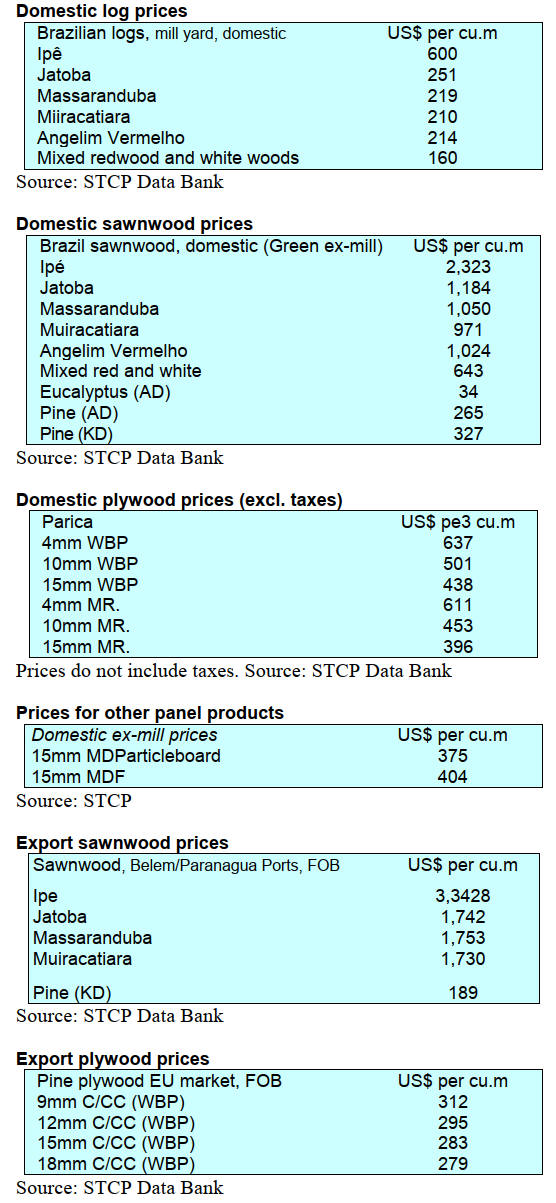 
Through the eyes of industry
The latest GTI report lists the challenges identified by the private
sector in Brazil.
See:
https://www.itto-ggsc.org/static/upload/file/20231121/1700552181514582.pdf
9. PERU
Exports fell between
January and September
Shipments of wood products between January and
September totalled US$76.2 million, a decline of 26%
compared to the same period in 2022 (US$102.7 million)
according to the Services and Industries Management/
Extractives division of the Association of Exporters
(ADEX).
This contraction is partly explained by lower orders from
the two main buyers, China (US$15.5 million) and France
(US$11.5 million) which declined by 25% and 29%,
respectively. In China the real estate sector crisis
dampened demand whereas in the French market recent
price increases for wood products from Peru undermined
competitiveness compared to suppliers elsewhere. Other
markets for wood products from Peru were Mexico
(US$11.1 million), the Dominican Republic (US$8.1
million) but down over 40% and the US (US$6.3 million)
down 24%.
According to figures from the ADEX Commercial
Intelligence System sawnwood was the most exported
product as of November 2023 earning US$32.1 million, a
decrease of 18%. Second ranked products were semi-
manufactured products which earned US$ 27.8 million
despite falling 43% year on year.
ADEX: exports could be 30% down this year
According to ADEX, Peruvian wood product exports in
2023 are likely to be around US$89 million which would
represent a year on year contraction of 30% year on year
compared and a drop of 60% compared to 2018 (US$219
million) when a historical maximum was reached.
Erik Fischer Llanos, the president of the ADEX Timber
and Wood Industries Committee said “Our 14 million
hectares of permanent production forests must be valued
appropriately. We (Peru) are the second largest country in
terms of forest area surpassed only by Brazil but Ecuador
and Uruguay, with less forest, export more wood products
than Peru”. Fischer called for the implementation of
measures that promote the growth of the forestry sector
such as the implementation of a new forestry concession
processes where priority is given to granting rights to
companies which have the technical and economic
resources to ensure sustainable management of the forest.
He added, Peru loses more than 150,000 hectares of
forests annually from shifting agriculture. Fischer also
commented that the inclusion of the shihuahuaco species
(internationally known as Cumarú) in Appendix II of the
International Convention on Endangered Species of Wild
Fauna and Flora (CITES) has created uncertainty in the
market and driven down demand and prices. As of
October 2023 prices in international markets for Cumarú
decking were down 25% and prices for slats were down
37%.
See:
https://agraria.pe/noticias/adex-exportaciones-de-madera-por-parte-de-peru-sumarian-cerc-34003
Completion of Ucayali forest zoning
Through a joint effort between the National Forestry and
Wildlife Service (SERFOR) and the Regional Government
of Ucayali (GOREU) with support from the Regional
Forestry and Wildlife Management (GERFFS) authority in
Ucayali zoning was completed marking an important step
to promote sustainable use of forest resources and wildlife
in the Department.
With the completion of the zoning, the territory will be
able to sustainably take advantage of forest and wildlife
resources according to their potential and limitations. In
addition, this process took into account economic, social,
cultural and ecological aspects to classify the territory into
four categories, which will allow effective management.
What remains now is to send details to SERFOR for
evaluation and subsequent sending to the Ministry of the
Environment (MINAM) for approval through a ministerial
resolution.
See:
https://www.gob.pe/institucion/serfor/noticias/876101-se-logro-la-culminacion-de-la-zonificacion-forestal-de-ucayali
Review of the Sustainable Productive Forests (BPS)
programme
According to Alberto Gonzales-Zúñiga, the Director of the
National Forestry and Wildlife Service (SERFOR), the
Sustainable Productive Forests (BPS) programme is
advancing at a steady pace.
This was his comment during a meeting together with the
executive coordinator of BPS, Daniel Rivera and his entire
team. At the meeting SERFOR informed representatives
of the German Development Bank - KfW on the current
status of the programme as well as the progress in
achieving the objectives of the programme and the
strategies that will be implemented to promote the
progress of its three projects: Forest Plantations, Forest
Management and Forest Planning.
Andreas Weitzel, representative of the German
Development Bank KfW, highlighted how important
forest conservation is for them at an international level.
“In Germany, forests are very important and valuable. The
forestry sector in our country has a study of more than 500
years, one of the oldest in the world. Our goal is to be a
support so that forests around the world can be preserved”,
he said.
It was decided that additional specilaists will be required
lead the technical and administrative areas and those
related to risk management, follow-up and monitoring,
government control and incentive funds.
See: https://www.gob.pe/institucion/serfor/noticias/875218-el-serfor-y-el-banco-de-desarrollo-aleman-se-reunen-para-revisar-avances-del-programa-bosques-
productive-sustainable-bps
In related news, SERFOR staff in Oxapampa, Pasco
Region discussed the Forest Plantations - Sustainable
Productive Forests (BPS) programme an initiative co-
financed by the German Development Bank - KfW.
The project seeks to promote the creation of more than
2,000 hectares of plantations in Oxapampa through
economic incentives to native communities. More than 90
people from the local and regional government were
present at this event along with civil society organisations,
academia, companies and native communities from across
the Department of Pasco.
See:https://www.gob.pe/institucion/serfor/noticias/873238-serfor-lanzo-el-proyecto-plantaciones-forestales-en-oxapampa
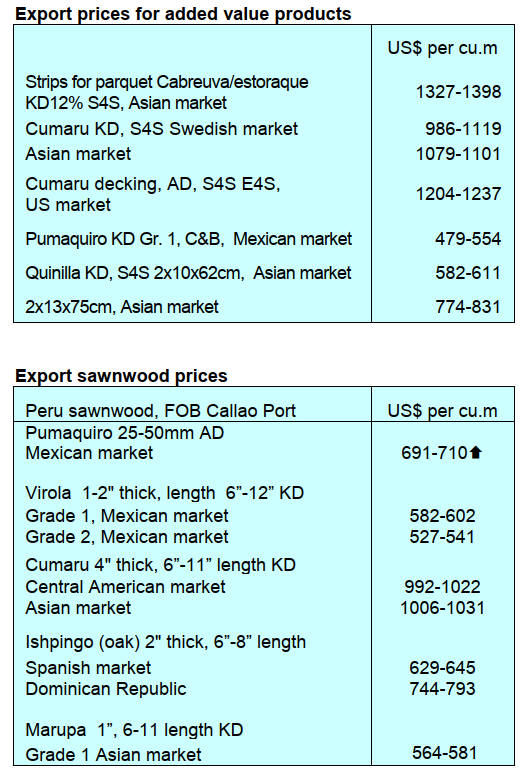 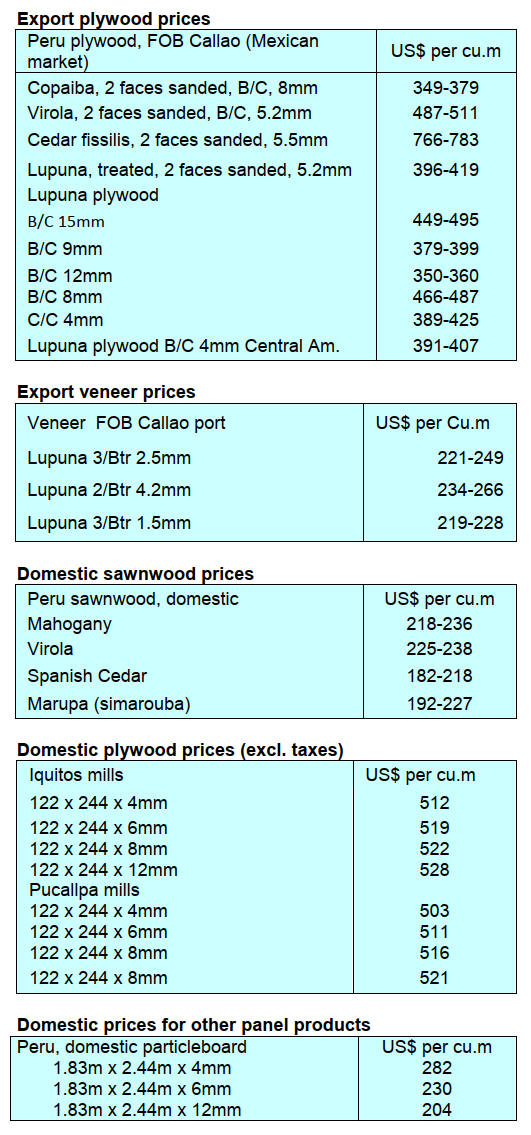
|